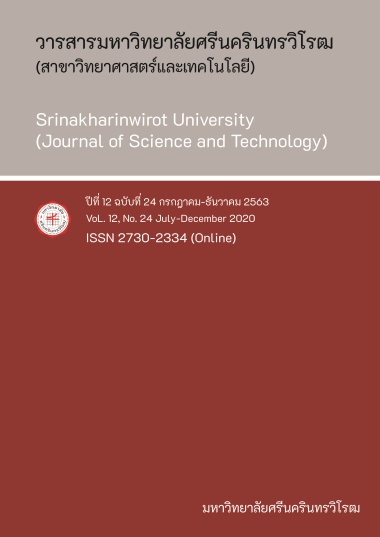การใช้เตาเผาไฟฟ้าแบบขดลวดความต้านทานสำหรับการสังเคราะห์อะลูมิเนียม พิลลาร์มอนต์โมริลโลไนต์ APPLICATION OF AN ELECTRIC RESISTANCE FURNACE FOR SYNTHESIS OF Al-PILLARED MONTMORILLONITE
Keywords:
Adsorption, Electric resistance furnace, Al-pillared montmorillonite, Alkylamine chloroanthraquinone, Copper IonAbstract
In this research, a low-cost electric furnace was designed and fabricated by using resistant coils that provided the maximum heating temperature up to 1,200°C. The furnace was made of refractory bricks, ceramic fibers, ceramic rods, resistant coils, and silica boards, a thermocouple was installed inside. The furnace can be used for calcination of aluminum pillared montmorillonite (Al-Mt1 and Al-Mt2). The prepared montmorillonites were characterized by various techniques such as Fourier transform infrared spectroscopy. The results confirmed the presence of pillars because of the decrease in the intensity of OH and Si-O-Si groups. The data from Brunauer Emmett-Teller displayed the specific surface area of Al-Mt1 (217.3625 m2/g) was greater than that of Al-Mt2 (203.2639 m2/g). The N2 adsorption isotherms exhibited Type IV behaviors according to the IUPAC classification. Moreover, alkylamine chloroanthraquinone molecules (L) were added to the Al-Mt1 and Al-Mt2 structures to form AlMt1-L and AlMt2-L, respectively. The prepared materials were used as adsorbent for removal of copper ion (Cu2+) and were characterized by UV-visible spectroscopy. The Cu2+ removal efficiency using AlMt1-L was around 10% higher than that of AlMt2-L. In addition, the quantity of Cu2+ adsorbed (qt) by AlMt1-L was about four times higher than
that of AlMt2-L.
Downloads
References
[2] Phromphuek, T. (1982). Furnace and Firing. Bangkok: Supervisory unit, Department of Teacher Training.
[3] Leksawat, S. (2005). Pottery: Elemental Design and Practice. Bangkok: Chulalongkorn University Press.
[4] Alibaba. (2018). Electric Kiln. Retrived January 7, 2019, from https://www.alibaba.com /trade/search?fsb=y&IndexArea=product_en&CatId=&SearchText=electric+kiln&viewtype
[5] Jeon, E.; Ryu, S.; Park, S.; Wang, L.; Tsang, D.C.W., & Baek, K. (2018). Enhanced Adsorption of Arsenic onto Alum Sludge Modified by Calcination. Journal of Cleaner Production, 176, 54-62.
[6] Kim, B.K.; Lee, D.Y.; Gwak, G.H.; Han, Y.S., & Oh, J.M. (2019). Zn-Fe Mixed Metal Oxides from Metal Hydroxide Precursor: Effect of Calcination Temperature on Phase Evolution, Porosity, and Catalytic Acidity. Journal of Solid State Chemistry, 269, 454–458.
[7] Fan, H.; Zhou, L.; Jiang, X.; Huang, Q., & Lang, W. (2014). Adsorption of Cu2+ and Methylene Blue on Dodecyl Sulfobetaine Surfactant-modified Montmorillonite. Applied Clay Science, 95, 150-158.
[8] Li, J.; Jiang, B.; Liu, Y.; Qiu, C.; Hu, J.; Qian, G.; Guo, W., & Ngo, H. (2017). Preparation and Adsorption Properties of Magnetic Chitosan Composite Adsorbent for Cu2+ Removal. Journal of Cleaner Production, 158, 51-58.
[9] Thongkum, D.; Punaray, J.; Sanguankul, W.; Ratchakom, V., & Kumplong, P. (2015). Alkylamine Anthraquinone Chemical Sensors to Detect Nickel and Copper Ions. Srinakharinwirot Science Journal, 31(1), 51-64.
[10] Kaur, N., & Kumar, S. (2008). A Differential Receptor for Selective and Quantitative Multi-ion Analysis for Co2+ and Ni2+/Cu2+. Tetrahedron Letters, 49, 5067-5069.
[11] Pereza, R.; Molinab, I.; Lopeza, J.; Jalil, R.; Sapagc, K.; Sapagc, E., & Castellona, R. (2012). Al-pillared Montmorillonite as a Support for Catalysts Based on Ruthenium Sulfide in HDS Reactions. Catalysis Today, 187, 88-96.
[12] Molu B.Z., & Yurdakoc, K. (2010). Preparation and Characterization of Aluminum Pillared K10 and KSF for Adsorption of Trimethoprim. Microporous and Mesoporous Materials, 127, 50-60.
[13] Yu, R.; Wang, S.; Wang, D.; Ke, J.; Xing, X.; Kumada, N., & Kinomura, N. (2008). Removal of Cd2+ from Aqueous Solution with Carbon Modified Aluminum-pillared Montmorillonite. Catalysis Today, 139, 135-139.
[14] Achma, B.; Ghorbel, A.; Dafinov, A., & Medina, F. (2012). Synthesis of Stable Cu-supported Pillared Clays for Wettyros Oloxidation with H2O2. Journal of Physics and Chemistry of Solids, 73, 1524-1529.
[15] Qin, Z.; Yuan, P.; Zhu, J.; He, H.; Liu, L., & Yang, S. (2010). Influences of Thermal Pretreatment Temperature and Solvent on the Organosilane Modification of Al13-intercalated/Al-pillared Montmorillonite. Applied Clay Science, 50, 546-553.
[16] Datta, D.; Uslu, H., & Kumar, S. (2015). Adsorptive Separation of Cu2+ from an Aqueous Solution Using Trioctylamine Supported Montmorillonite. Journal of Chemical and Engineering Data, 60, 3193-3200.
[17] Gao, H.; Zhao, B.; Luo, J.; Wub, D.; Ye, W.; Wang, Q., & Zhang, X. (2014). Fe–Ni–Al Pillared Montmorillonite as a Heterogeneous Catalyst for the Catalytic Wet Peroxide Oxidation Degradation of Orange Acid II: Preparation Condition and Properties Study. Microporous and Mesoporous Materials, 196, 208-215.
[18] Wang, G.; Hua, Y.; Suc, X.; Komarneni, S.; Ma, S., & Wang, Y. (2016). Cr(VI) Adsorption by Montmorillonite Nanocomposites. Applied Clay Science, 124-125, 111-118.
[19] Gao, Y.; Li, W.; Sun, H.; Zheng, Z.; Cui, X.; Wang, H., & Meng, F. (2014). A Facile in situ Pillaring method-the Synthesis of Al-pillared Montmorillonite. Applied Clay Science, 88-89, 228-232.
[20] Liu, C.; Cai, W., & Liu, L. (2018). Hydrothermal Carbonization Synthesis of Al-pillared Montmorillonite@carbon Composites as High Performing Toluene Adsorbents. Applied Clay Science, 162, 113-120.
Downloads
Published
How to Cite
Issue
Section
License
Srinakharinwirot University Journal of Sciences and Technology is licensed Under a Creative Commons Attribution-NonCommercial-NoDerivs 4.0 International (CC-BY-NC-ND 4.0) License, Unless Otherwise Stated. Please Read Journal Policies Page for More Information on Open Access, Copyright and Permissions.



